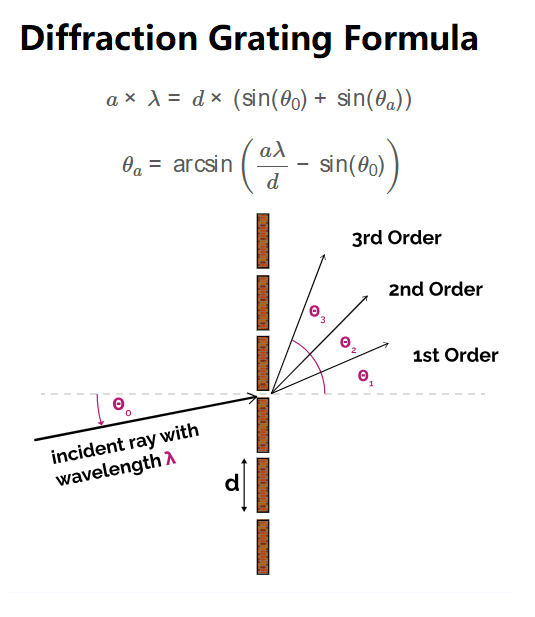1. What is Diffraction Grating Calculator?
Definition: This calculator computes the diffraction angles (\( \theta_a \)) for different orders of a diffraction grating, which splits light into its component wavelengths based on interference.
Purpose: It is used in optics to determine the angles at which light of a specific wavelength will diffract, useful in spectroscopy and optical experiments.
2. How Does the Calculator Work?
The calculator uses the diffraction grating equation:
Formula:
\[
a \times \lambda = d \times (\sin(\theta_0) + \sin(\theta_a))
\]
Rearranged to solve for \( \theta_a \):
\[
\theta_a = \arcsin\left(\frac{a \lambda}{d} - \sin(\theta_0)\right)
\]
Where:
- \( \lambda \): Wavelength of the incident ray (m, mm, μm, nm, pm, Å)
- \( d \): Grating spacing (m, mm, μm, nm, pm, Å)
- \( \theta_0 \): Angle of incidence (rad, deg)
- \( \theta_a \): Diffraction angle for order \( a \) (rad, deg)
- \( a \): Order of the diffracted image (positive integer, e.g., 1, 2, 3, ...)
Unit Conversions:
- Wavelength (\( \lambda \)) and Grating Spacing (\( d \)): m, mm (1 mm = \( 10^{-3} \) m), μm (1 μm = \( 10^{-6} \) m), nm (1 nm = \( 10^{-9} \) m), pm (1 pm = \( 10^{-12} \) m), Å (1 Å = \( 10^{-10} \) m)
- Angles (\( \theta_0 \), \( \theta_a \)): rad, deg (1 deg = \( \frac{\pi}{180} \) rad)
- Grating Density: lines/mm (converted to \( d \) in meters by \( d = \frac{1}{\text{density} \times 1000} \))
Steps:
- Enter the wavelength (\( \lambda \)), grating density (lines/mm), angle of incidence (\( \theta_0 \)), and maximum order to calculate.
- Convert \( \lambda \) to meters and compute \( d \) from the grating density.
- Convert \( \theta_0 \) to radians.
- For each order \( a \), calculate \( \sin(\theta_a) = \frac{a \lambda}{d} - \sin(\theta_0) \).
- Compute \( \theta_a = \arcsin\left(\frac{a \lambda}{d} - \sin(\theta_0)\right) \).
- Convert each \( \theta_a \) to the selected unit (rad or deg).
- Display the results, using scientific notation for values less than 0.001, otherwise with 4 decimal places.
3. Importance of Diffraction Grating Calculation
Calculating diffraction angles is crucial for:
- Spectroscopy: Separating light into its component wavelengths to analyze the spectrum of a light source.
- Optics: Designing optical instruments like spectrometers and monochromators.
- Education: Understanding the principles of wave interference and diffraction in physics.
4. Using the Calculator
Examples:
- Example 1: For \( \lambda = 500 \, \text{nm} \), grating density = 1000 lines/mm, \( \theta_0 = 30^\circ \), max order = 3, angles in degrees:
- Convert: \( \lambda = 500 \times 10^{-9} \, \text{m} \), \( d = \frac{1}{1000 \times 1000} = 10^{-6} \, \text{m} \), \( \theta_0 = 30 \times \frac{\pi}{180} = 0.5236 \, \text{rad} \)
- \( \sin(\theta_0) = 0.5 \)
- Order 1: \( \sin(\theta_1) = \frac{1 \times 500 \times 10^{-9}}{10^{-6}} - 0.5 = 0.5 - 0.5 = 0 \), \( \theta_1 = 0 \, \text{rad} \approx 0^\circ \)
- Order 2: \( \sin(\theta_2) = \frac{2 \times 500 \times 10^{-9}}{10^{-6}} - 0.5 = 1 - 0.5 = 0.5 \), \( \theta_2 = \arcsin(0.5) \approx 0.5236 \, \text{rad} \approx 30^\circ \)
- Order 3: \( \sin(\theta_3) = \frac{3 \times 500 \times 10^{-9}}{10^{-6}} - 0.5 = 1.5 - 0.5 = 1 \), \( \theta_3 = \arcsin(1) \approx 90^\circ \)
- Example 2: For \( \lambda = 600 \, \text{nm} \), grating density = 500 lines/mm, \( \theta_0 = 0^\circ \), max order = 2, angles in radians:
- Convert: \( \lambda = 600 \times 10^{-9} \, \text{m} \), \( d = \frac{1}{500 \times 1000} = 2 \times 10^{-6} \, \text{m} \), \( \theta_0 = 0 \, \text{rad} \)
- \( \sin(\theta_0) = 0 \)
- Order 1: \( \sin(\theta_1) = \frac{1 \times 600 \times 10^{-9}}{2 \times 10^{-6}} - 0 = 0.3 \), \( \theta_1 = \arcsin(0.3) \approx 0.3047 \, \text{rad} \)
- Order 2: \( \sin(\theta_2) = \frac{2 \times 600 \times 10^{-9}}{2 \times 10^{-6}} - 0 = 0.6 \), \( \theta_2 = \arcsin(0.6) \approx 0.6435 \, \text{rad} \)
5. Frequently Asked Questions (FAQ)
Q: What is a diffraction grating?
A: A diffraction grating is an optical component with a periodic structure that splits light into its component wavelengths by interference, producing diffracted images at specific angles.
Q: Why might a diffraction angle not be possible for a given order?
A: If \( \sin(\theta_a) \) is not between -1 and 1, the diffraction angle is not physically possible for that order, as it exceeds the range of real angles.
Q: How do I determine the grating spacing \( d \)?
A: The grating spacing \( d \) is the inverse of the grating density (lines per unit length). For example, a density of 1000 lines/mm means \( d = \frac{1}{1000} \, \text{mm} = 10^{-6} \, \text{m} \).
Diffraction Grating Calculator© - All Rights Reserved 2025
 Home
Home
 Back
Back
